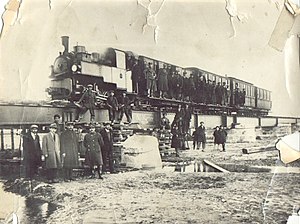Karatzova-Decauville Railway
| Karatzova-Decauville Railway | |||||||||||||||||||||||||||||||||||||||||||||||||
|---|---|---|---|---|---|---|---|---|---|---|---|---|---|---|---|---|---|---|---|---|---|---|---|---|---|---|---|---|---|---|---|---|---|---|---|---|---|---|---|---|---|---|---|---|---|---|---|---|---|
|
Decauville locomotive with a passenger train on a bridge
| |||||||||||||||||||||||||||||||||||||||||||||||||
|
Approximate route
| |||||||||||||||||||||||||||||||||||||||||||||||||
| Route length: | 29 + 13.5 km | ||||||||||||||||||||||||||||||||||||||||||||||||
| Gauge : | 600 mm ( narrow gauge ) | ||||||||||||||||||||||||||||||||||||||||||||||||
|
|||||||||||||||||||||||||||||||||||||||||||||||||
The Karatzova-Decauville-Bahn or Feldbahn Skydra – Aridea was an approximately 30 km long Decauville - military - narrow-gauge railway in the Greek part of Macedonia , built from 1916 by French and Serbian land forces , whose operation was finally stopped in 1936.
Surname
The name of the Karatzova-Decauville Railway ( Greek Καρατζόβα Ντεκοβίλ Karatzóva Dekovíl ) is derived from the Ottoman Karatza Ovasi (black valley), the later province and municipality of Almopia . The prefabricated track material and the rail vehicles were supplied by the French Société Decauville Aîné in Corbeil-Essonnes .
Route
The track network consisted of two lines: The main line, about 29 km long, connected the city of Skydra via Apsalos with Aridea and later Sosandra . The approximately 13.5 km long branch route connected Apsalos with Orma . The light railroad was mainly used to transport ammunition and to transport the wounded to the hospitals with 1,500 beds in Skydra, far behind the front line, operated by the Serbian army.
history
During the First World War, the railway line, like the parallel Kodza-Déré-Decauville , was of strategic importance for the preparation and implementation of the Battle of Skra-di-Legen .
The route from Skydra to Aridea was built by the French and Serbs within five months from July 1916. Work began on July 18, 1916 and by August 12, 1916, the route from Skydra to Nea Zoi was completed. With the completion of the Apsalos – Xifiani section on September 10, 1916, the entire Skydras – Xifiani line was completed. Two days earlier, on September 8, 1916, it was decided to extend the route to Aridea, the headquarters of the Swamedia Division. In the bi-weekly report of October 16, 1916, General Maurice Sarrail announced the start of work on this line extension, which was completed in early December 1916. Five months after the start of construction, the Decauville Skydras – Aridea railway was fully operational.
In 1918 the railway from Aridea to Sosandra was extended. In the same year, 1918, a branch line from Apsalos to Orma was built and put into operation. The construction of the line to Orma began on July 20, 1918. On August 28, 1918 the section Apsalos - Megaplatanos was completed, and a few days later the short section to Orma.
business
The route had a transport capacity of 400–600 tons per day. In total, around 600 guns and 85,000 people were transported in the few years of operation. In addition, an average of 29 tons of luggage, over 6 tons of goods and 9 tons of animals were transported every day.
post war period
The French bequeathed the Decauville narrow-gauge railways laid in this area to the Greek government, which in 1923 left their operation to the private entrepreneur and banker Epaminondas Charilaos , who owned and built the Charilaou settlement in Thessaloniki . Later, the Greek state transferred the operation of the network to the Local Railways of Macedonia ( Τοπικοί Σιδηρόδρομοι Μακεδονίας ), which finally ceased operations in the economic crisis of 1936. Immediately afterwards, the demolition of the tracks began, and the locomotives and wagons were moved to other narrow-gauge networks.
Most of the tracks and bridges were dismantled in the post-war period, but the route is still visible in places today. Former station buildings are still in Megaplatanos, Aridea, Apsalos and Xifiani. In addition, a short section of track at the former Apsalos train station and a steel bridge have been preserved. The only surviving locomotive on the Almopia network is now on display in the Athens Railway Museum. The historical significance of the narrow-gauge railways for the region has largely been forgotten.
Web links
- The Almopia Decauville train (English)
- The train of Karatzova. (English)
Individual evidence
- ↑ a b c d e The train of Karatzova.
- ↑ a b c Mauro Bottegal: Ferrovie portatili della Prima Guerra Mondiale . 2019, www.lulu.com , ISBN 978-0-244-15427-1 . Page 95.
- ↑ Rapport de renseignements No. 20 178-2 of September 2, 1916.
- ↑ Compte-rendu of September 18, 1916.
- ↑ Rapport de novembre 1367/4 of December 3, 1916.
- ↑ Compte-rendu of May 8, 1918.
- ↑ Compte-rendu of September 1918.
- ↑ a b Nikeforos Sivena : The Almopia Decauville train February 19, 2017. Accessed March 4, 2019.
- ↑ a b Νικηφόρου Σιβένα (Nikeforos Sivena): Η ιστορία της δημιουργίας του τρένου της Αλμωπίας (Καρατζόβας) (The story of the creation of Almopia). February 1, 2017. Retrieved August 21, 2018 and March 4, 2019, plus Greek WordPress version .
- ↑ Government Gazette No. 243 of August 29, 1923. (Greek)
Coordinates: 40 ° 53 ′ 14.9 " N , 22 ° 4 ′ 7.9" E


